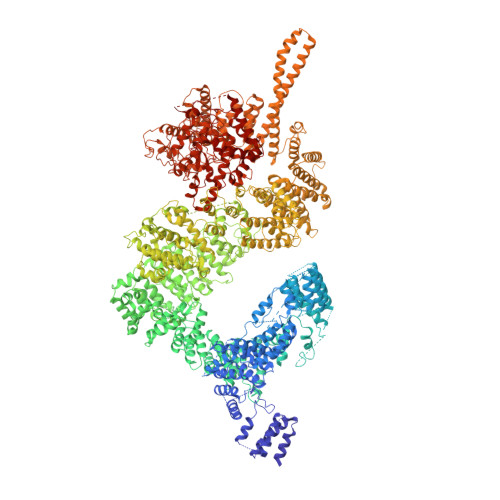Structural basis of allosteric regulation of Tel1/ATM kinase.
Xin, J., Xu, Z., Wang, X., Tian, Y., Zhang, Z., Cai, G.(2019) Cell Res 29: 655-665
- PubMed: 31097817
- DOI: https://doi.org/10.1038/s41422-019-0176-1
- Primary Citation of Related Structures:
6JXA, 6JXC - PubMed Abstract:
ATM/Tel1 is an apical kinase that orchestrates the multifaceted DNA damage response. Mutations of ATM/Tel1 are associated with ataxia telangiectasia syndrome. Here, we report cryo-EM structures of symmetric dimer (4.1 Å) and asymmetric dimer (4.3 Å) of Saccharomyces cerevisiae Tel1. In the symmetric state, the side chains in Tel1 C-terminus (residues 1129-2787) are discernible and an atomic model is built. The substrate binding groove is completely embedded in the symmetric dimer by the intramolecular PRD and intermolecular LID domains. Point mutations in these domains sensitize the S. cerevisiae cells to DNA damage agents and hinder Tel1 activation due to reduced binding affinity for its activator Xrs2/Nbs1. In the asymmetric state, one monomer becomes more compact in two ways: the kinase N-lobe moves down and the Spiral of α-solenoid moves upwards, which resemble the conformational changes observed in active mTOR. The accessibility of the activation loop correlates with the synergistic conformational disorders in the TRD1-TRD2 linker, FATC and PRD domains, where critical post-translational modifications and activating mutations are coincidently condensed. This study reveals a tunable allosteric network in ATM/Tel1, which is important for substrate recognition, recruitment and efficient phosphorylation.
- First Affiliated Hospital of USTC, School of Life Sciences, University of Science and Technology of China, Hefei, 230027, Anhui, China.
Organizational Affiliation:
















